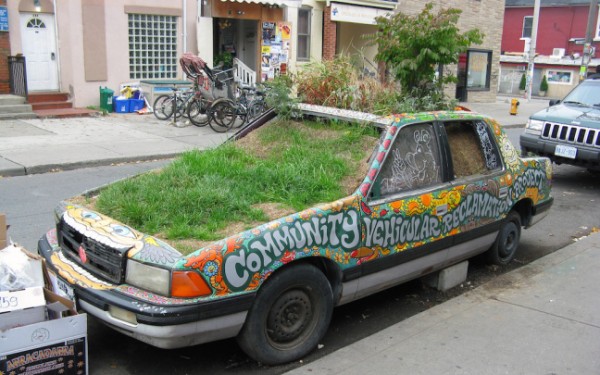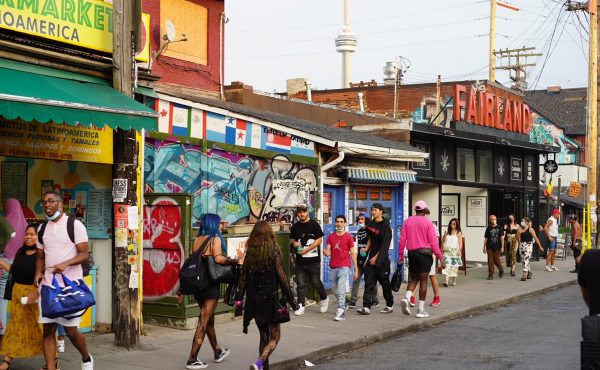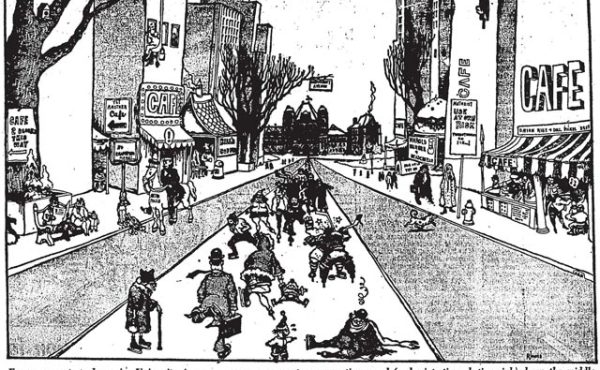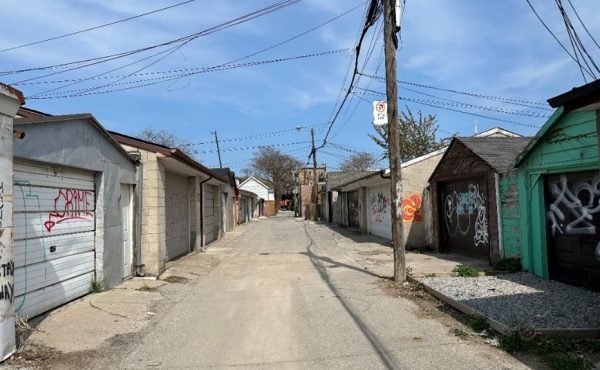One of the first areas I take people when they visit Toronto is usually Kensington Market – that dense grid of narrow streets stuffed with fruit and veggie stores, cafes, colourful vintage shops, and taco joints.
It’s fun to navigate the market, threading between parked or slowly moving cars, crossing from one side to the other with just a casual glance over the shoulder. Kensington has a lively energy to which many other neighbourhoods aspire. It’s a neighbourhood that has found its pedestrian-friendly groove.
You won’t find special paving here, or curbless streets, or bollards, or any of the other tactics designers and planners now mobilize to make other areas pedestrian-friendly and people-centric. It Kensington it just kinda…happens.
Still, in an article published in the Toronto Star, urban affairs critic Christopher Hume argues that banning cars from Kensington is the “obvious move” and the area is a “battleground” between cars and people on foot? A battleground? If any neighbourhood in Toronto can least be described as a battleground between cars and people, it’s Kensington Market. More of a slow dance, really.
Pedestrian-only Sundays are great, but I would hazard a guess that they’re great because they’re pedestrian-only Sundays and not pedestrian-only all-the-times.
Go to Kensington and watch the main streets. Cars go slower, people spill off of the sidewalk and walk in the road or cross back and forth. This is Kensington’s special sauce. By removing an ingredient you risk ruining it.
Pedestrianization is a means to an end, not an end in itself.
The desired end is usually a lively, comfortable, safe place that people like to go and hang out. Sometimes removing cars is the way to do it. Ryerson’s Gould Street is a great example of an area that has flourished since cars were banished and people allowed to flood into the space.
But sometimes it’s the slow mix of cars and people and bikes that makes certain areas what they are. Go to Boston’s North End and you find the same thing. Narrow streets with people spilling out of Italian restaurants, cars winding their way slowly through it all. It works because everyone understands that people come first.
We have something really special in Kensington right now, something that emerged on its own, over time. If it ain’t broke, don’t fix it.
photo by Diego Torres Sylvester on Flickr (cc)
This post was originally posted on This Land is Parkland, a blog about open spaces, large and small. Jake Tobin Garrett is the manager of policy and research at Park People.





5 comments
Old city of Toronto would have pedestrianized Kensington Market by now. Not so with the new city of Toronto, because of the auto-addicted councillors.
I don’t see how cars add anything to this neighborhood. Cars are a form of transportation and suited to environments where there is room for human error; Kensington is not that. People spill into the streets because it’s dense with pedestrians and the sidewalks are too narrow for the volume of people. There is too much valuable space being used for a handful of people with the intention of passing through.
Toronto lacks pedestrian only zones. Why are we fighting to preserve this?
Interesting read. Although I agree it largely works now as a shared space, there is the chance it would work even better if we eliminate the heavy machinery (cars). Kensington Market is a hipster heaven of younger to older adults and there aren’t many children or seniors in the area. If we eliminate the cars perhaps our streets will be safer for kids to play in again, and curbs can be removed to increase accessibility for the elderly. It could achieve a whole new level of street animation.
Kensington is great, but I would argue it isn’t comfortable for people of all ages yet, and it can still be improved without destroying the character. The people, buildings and character will stay there, we just make the street space more equitable and less dangerous.
You’re assuming cars would be replaced with nothing, for a net loss of activity. Fill the vacated road space with small vendors, street performers, public furniture, playground equipment, etc. and nobody will miss the cars.
Kensington basically operates as a giant woonerf as is. There can maybe be steps taken to officially woonerf it a bit more (i.e., lower curbs), but it works pretty well regardless. Any further process of pedestrianization would likely be slow and over a generation and that’s probably the way it should work. I don’t think the Market takes well to it being told to operate a certain way, nor should it.